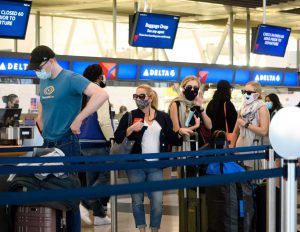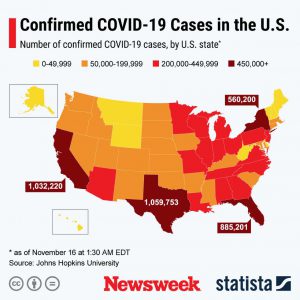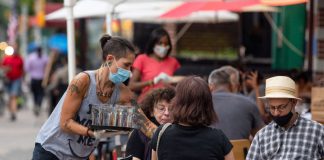NOVEMBER 18, 2020
Ahead of Thanksgiving, several states have issued updated travel advisories amid the ongoing COVID-19 pandemic to help reduce the risk of spreading infection.

Travelers at John F. Kennedy International Airport on November 7 in New York City. New York is among several states that have issued new quarantine rules ahead of Thanksgiving. – Getty Images
Here we look at the states where travelers are either required or recommended to quarantine after arrival.
California
The California Department of Public Health (CDPH) “strongly recommends” residents remain at home or within their region and avoid non-essential travel.
Those arriving in California from other states or countries, including returning California residents, “should practice self-quarantine for 14 days after arrival. These persons should limit their interactions to their immediate household,” the CDPH said in a statement last week.
New York
As of November 4, a travel advisory has been in effect allowing travelers to New York to “test out” of the mandatory 14-day quarantine, New York State Department of Health advised.
The new guidelines apply to “any traveler to New York State from a noncontiguous state, U.S. territory or CDC level 2 or level 3 country” under the CDC Health Notice.
The new guidelines for travelers to “test-out of the mandatory 14-day quarantine” include the following.
For travelers who were out-of-state for more than 24 hours:
- Travelers must obtain a test within three days of departure, prior to arrival in New York.
- The traveler must, upon arrival in New York, quarantine for three days.
- On day 4 of their quarantine, the traveler must obtain another COVID test. If both tests comes back negative, the traveler may exit quarantine early upon receipt of the second negative diagnostic test.
For those who were out-of-state for less than 24 hours:
- The traveler does not need a test prior to their departure from the other state, and does not need to quarantine upon arrival in New York State.
- However, the traveler must fill out a traveler form upon entry into New York State, and take a COVID diagnostic test 4 days after their arrival in New York.
The latest guidance applies to international travelers coming from any country with either a level 2 or level 3 designation under the CDC Health Notice.
“Travelers from states that are contiguous with New York are exempt from the travel advisory,” as are essential workers. See the state health department website for full details on the latest advisory.
New Jersey
Those traveling to New Jersey from “states with increasing rates of COVID-19” are advised to quarantine for 14 days. This includes those traveling by train, bus, car, plane and any other method of transportation.
“The 14-day quarantine travel advisory applies to travel from certain ‘impacted states’ identified as those that 1) have an average daily number of new cases higher than 10 per 100,000 residents over a seven-day period or 2) have a 10 percent or higher positivity rate over a seven-day period. The advisory applies to travel from states that meet either of these levels,” the state government notes.
Visit the state government website to see which states are designated as “impacted states.”
Connecticut
Those heading into Connecticut from any state (other than New York, New Jersey, or Rhode Island) with “a positive case rate higher than 10 per 100,000 residents or higher than a 10 percent test positivity rate over a seven-day rolling average” are “directed to self-quarantine for a 14-day period from the time of last contact within the identified state or country,” the state government stated.
The rule also applies to those traveling from a country with a Level 3 CDC Health Notice designation.
“Failure to self-quarantine or to complete the [state’s] Travel Health Form may result in a civil penalty of $500 for each violation,” the state government said.
See the state government website for more information.
Pennsylvania
From November 20, the Pennsylvania Department of Health will require anyone traveling from another state, both residents and visitors, to have a negative COVID-19 test within 72 hours prior to arrival.
“If someone cannot get a test or chooses not to, they must quarantine for 14 days upon arrival in Pennsylvania.
“This does NOT apply to people who commute to and from another state for work or medical treatment,” the department said.
Illinois
While there is no statewide travel advisory, Chicago, the state’s most populous city, modified its existing “Emergency Travel Order” last week.
From November 13, all states are placed in one of three categories–red, orange or yellow–”based on the status of the outbreak in the states and how the data compares to the situation in Chicago,” the city government website advised.
“Anyone traveling from a state on the Orange list is directed to obtain a negative COVID-19 test result no more than 72 hours prior to arrival in Chicago or quarantine for a 14-day period (or the duration of their time in Chicago, whichever is shorter). Anyone traveling from a state on the Red list must quarantine for a 14-day period or the duration of their time in Chicago, whichever is shorter.
See the city government website for details on exemptions and more information.
Massachusetts
All travelers arriving in Massachusetts, both residents and visitors are required to complete the Massachusetts Travel Form before arrival (unless you’re traveling from a lower-risk state designated by the Department of Public Health) as well as quarantine for 14 days or produce a negative COVID-19 test result from a test done 72 hours prior to arrival.
“If your COVID-19 test result has not been received prior to arrival, visitors, and residents must quarantine until they receive a negative test result,” the state government notes.
See the state government website for more information.
Maine
All out-of-state travelers, both residents and visitors, are required to complete a 14-day quarantine upon arrival.
Those under the quarantine mandate are required “to arrive with enough food for 14 days or arrange to have food delivered to you. You cannot go out to grocery stores,” as well as “stay at home. You cannot go out to public places,” the state government website notes.
You will also need to “avoid contact with others, especially those who are at high risk of severe COVID-19 illness,” the government states.
Maryland
Residents or visitors traveling from out-of-state “should either get tested for COVID-19 promptly upon arrival in Maryland or within 72 hours before travel to Maryland,” the Maryland Department of Health said in an advisory released on November 10.
“Any Marylander who travels to a state with a COVID-19 test positivity rate above 10 percent or with a case rate over 20 per 100,000 in the past seven days should get tested andself-quarantine at home until the test result is received,” the department said.
Washington, D.C., Virginia, Pennsylvania, Delaware and West Virginia are exempt from the latest recommendation.
Vermont
The state health department “strongly advises” against non-essential travel, including within the state, while all non-essential travel to and from Vermont requires a 14-day quarantine. See the department website for full details.
Hawaii
Both residents and visitors traveling to Hawaii from out-of-state are subject to a mandatory 14-day quarantine.
“However, the state’s Pre-Travel Testing Program allows individuals to proceed without having to self-quarantine. The program requires passengers five and older to take a Nucleic Acid Amplification Test (NAAT) from a Clinical Laboratory Improvement Amendments (CLIA) certified laboratory within 72 hours from the final leg of departure and produce a negative result,” the Hawaii Tourism Authority said.
“Only test results from trusted testing partners approved by the Hawaii Department of Health are being accepted. A trained professional must observe all tests. Registration instructions and costs can be found at the partners’ websites,” the Hawaii Tourism Authority said.
Oregon
Travelers from out-of-state, both residents and visitors, “should practice self-quarantine for 14 days after arrival. These persons should limit their interactions to their immediate household,” the state government said.
Washington
Those traveling to Washington, both residents and visitors, from other states or countries “should practice self-quarantine for 14 days after arrival. These individuals should also limit their interactions to their immediate household,” the state government advised.
Rhode Island
The state health department requires all out-of-state visitors to complete a “certificate of compliance with out-of-state travel quarantine/testing requirements and out-of-state travel screening form upon arriving in Rhode Island.
“Travelers will be required to provide their completed certificate of compliance to their lodging and accommodations upon check-in,” the department said.
Those traveling to Rhode Island, both visitors and residents, from a state with a COVID-19 positivity rate of higher than five percent must quarantine for 14 days and “self-monitor for symptoms,” the department adds.
New Mexico
From September 4, New Mexico has required any individual traveling to the state from “states deemed high-risk based on COVID-positivity rates” to quarantine for 14 days from the date of entry into New Mexico or for the duration of their stay in the state, whichever is shorter.
See the state government website for more information.
Kansas
The Kansas Department of Health and Environment has issued a 14-day quarantine mandate after arrival for both residents and visitors who have traveled to and from a selection of states and countries between certain dates.
The quarantine rule applies to those who:
- Attended/traveled to mass gathering events out-of-state of 500 people or greater where individuals do not socially distance (six feet) and wear masks.
- Travel to or from South Dakota between November 4 and 17.
- Travel to or from Belgium and Czechia between November 4 and 17.
- Travel to or from North Dakota between October 21 and November 17.
- Travel to or from the country of Andorra between October 21 and November 17.
- Been on a cruise ship or river cruise on or after March 15.
Anyone who received notification from either state or local public health authorities that they are “a close contact of a laboratory-confirmed case of COVID-19,” will also need to quarantine for 14 days.
“Mass gatherings are defined as any event or convening that brings together 500 or more persons in a single room or space at the same time such as an auditorium, stadium, arena, large conference room, meeting hall, theater or any other confined indoor or outdoor space,” the department said.
Kentucky
From July 20, the Kentucky Department for Public Health has recommended a 14-day self-quarantine for those who traveled to any states reporting a “positive testing rate equal to or greater than 15 percent of COVID-19 testing,” as well as for those returning from any international travel.
The department said: “It is recommended to use extra precaution traveling to states reporting positive testing rate equal to or greater than 10 percent-of COVID-19 testing,” while “non-essential travel, both for pleasure and work, is strongly discouraged.”
Ohio
Those traveling to Ohio from states with a COVID-19 positive testing rate of 15 percent or higher are advised to quarantine for 14 days, according to the Ohio Department of Health.
This guideline applies to both leisure and business travel as well as for both residents and visitors.
Alaska
Non-resident travelers to Alaska can either submit a Travel Declaration and Self-Isolation Plan and arrive with proof of a qualifying negative COVID-19 test or get tested when they arrive in Alaska (by purchasing a $250 COVID-19 test) and self-quarantine at their expense until the results arrive, according to the state government website.
Alaska residents can get a free COVID test on arrival or choose to quarantine for 14 days rather than be tested.
The wider picture
The novel coronavirus has infected more than 55.7 million people since it was first reported in Wuhan, China.
More than 1.3 million people have died worldwide and more than 35.9 million have recovered as of Wednesday, according to Johns Hopkins.
The graphic below, produced by Statista, shows the spread of COVID-19 cases across the U.S.

Courtesy/Source: Newsweek

































































































